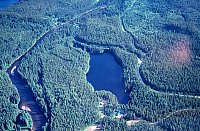
PHOTO 1. Air Photo of Tsitniz Lake, July
2000
Click image to view 82K JPG |
|
|
Recreational Fishery
Stock Assessment
1998 Final Report
|
Introduction
| |
TABLE 1. Physical Attributes of Tsitniz Lake*
| Waterbody identifier |
00499WILL |
| Water surface area |
9.1ha. |
| Area above 6 m contour |
4.3 ha. |
| Shoreline perimeter |
1680 m |
| Maximum depth |
14.3 m |
| Volume |
685,816m3 |
| Mean depth |
7.6 m |
| Elevation |
762 m |
* as of October 1, 1968 |
|
This report presents the results of a stock assessment
of Tsitniz Lake, completed by Ted Zimmerman and Sean Barry
on June 18, 1998. Tsitniz Lake was initially stocked
with rainbow trout in 1963 and subsequently received
alternate year releases, until a 1980 creel census revealed
that angler interest in the lake had diminished. After an
11 year hiatus from 1983 to 1993, the lake was placed back
on the stock schedule in 1994 to address both renewed angler
interest and the recreational needs of Camp McInnis, which
is located on the lake. The current assessment is the first
to examine the growth and abundance of stocked rainbow trout
in Tsitniz Lake.

Methods
| |
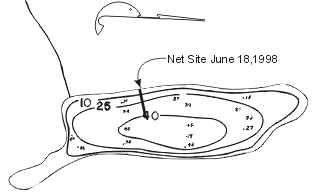 FIGURE 1. Location of 1998 Tsitniz Lake gill
net set.
FIGURE 1. Location of 1998 Tsitniz Lake gill
net set.
Click image to view 19K GIF |
|
An experimental, 91.2m sinking monofilament gill net was
set in Tsitniz Lake on June 18,1998 according to the methods
outlined in the Resource Inventory Committee document Fish
Collection Methods and Standards. The net was deployed
at 10:29 AM and retrieved the same day at 8:54 PM, for a
total soak time of 10 hours, 25 minutes. The net was set
in a E-W direction from the west shore (Figure
1), and ranged in depth from the surface to approximately
7.5m.
All trout collected were sampled for fork
length. Due to the large numbers of yearlings captured,
only a portion of the smaller fish were sampled for weight,
sex, and maturity (Appendix1).
Scale samples were collected from all fish larger than
200 mm, and from a sub-sample of those smaller than 200
mm. The scales were sent to Darlene
Gillespie of TimeMark Consulting Ltd. (Nanaimo, B.C.)
for ageing. Upon return to the Ministry, scale prints were
subsequently checked and ages were adjusted by the author
to account for anomalies between the ages reported by the
contractor and the known stock
schedule and postulated age composition of rainbow trout
for Tsitniz Lake.

Results and Discussion
| |
TABLE 2. Tsitniz Lake rainbow trout
population data, June 1998
| Attribute |
Mean |
Range |
SD |
| Length (mm) N=39 |
207 |
108-451 |
107 |
| Weight (g) N=18* |
400 |
105-925 |
189 |
| Condition N=18* |
1.01 |
0.86-1.25 |
0.11 |
|
*weight and condition assessed
for fish larger than 200mm only |
|
|
CATCH SUMMARY
The net catch yielded 42 rainbow trout (RB), for
a catch per unit effort (CPUE) of 4.0 RB per net-hour. The
CPUE for fish greater than 200 mm (i.e. 1995 cohorts and
older) was 1.4 RB per net-hour. 3 of the yearling rainbow
trout were damaged during retrieval, resulting in a sample
size of 39 fish (Appendix 1).
No other fish were captured. Of the 39 rainbow trout captured,
11 (28%) were female, 3 (8%) were male, and 25 (64%) could
not be classified.
| |
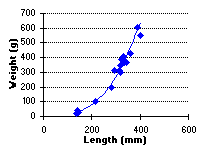 FIGURE 2. Length vs. weight of Tsitniz
Lake rainbow trout, June 18, 1998
FIGURE 2. Length vs. weight of Tsitniz
Lake rainbow trout, June 18, 1998
Click image to view 5K GIF |
|
|
| |
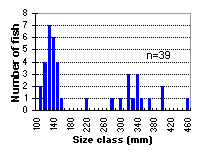 FIGURE 3. Length frequency distribution
of Tsitniz Lake rainbow trout, June 1998
FIGURE 3. Length frequency distribution
of Tsitniz Lake rainbow trout, June 1998
Click image to view 7K GIF |
|
|
| |
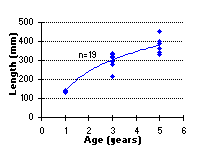 FIGURE 4. Age vs. length of Tsitniz Lake
rainbow trout, June 1998
FIGURE 4. Age vs. length of Tsitniz Lake
rainbow trout, June 1998
Click image
to view 7K GIF |
|
|
CONDITION
The weight of sampled Tsitniz Lake rainbow trout increased
according to the equation W = 4x10-5 x L2.9946;
this relationship is expressed in Figure
2. There were no anomolies noted in the length-weight
relationship, suggesting that Tsitniz rainbow trout remain
healthy throughout their growth period up to the maximum
age recorded in this survey. See Appendix
1 for individual fish data.
LENGTH FREQUENCY DISTRIBUTION
Figure 3 illustrates the length-frequency
distribution of the sample and includes all fish captured.
The 1998 sample is dominated by 110 - 160 mm yearlings which
were stocked into Tsitniz Lake on May 29, at a mean weight
of 7.8 g. The 3- and 5- year olds do not exhibit a tight
class affinity, however most 5-year-olds are represented
by the 350 mm and larger size classes.
The alternate year stock schedule is reflected in the size
class gaps observed in the length frequency distribution.
With only 2500 fish stocked every other year, densities
are low and this likely results in low catch rates per angler-hour.
Indeed, our net surveys yielded only 1.4 adult trout per
net-hour.
GROWTH
Figure 4 shows the length-at-age
relationship for rainbow trout in Tsitniz Lake. It is assumed
that natural recruitment is inhibited due to a lack of spawning
and rearing sites, and age classes have therefore been adjusted
to 1997, 1995 and 1993 cohorts. Five-year-old trout averaged
380 mm and 546 g (1.2 lbs), however one fish attained a
length of 451 mm and a weight of 925 g (2 lbs). The small
sample size of this age class (n=5) precludes any analysis
of the variability in these figures, however errors in the
ageing and age adjustment process may account for some of
the variance.

Management Recommendations
Tsitniz Lake appears to produce moderate sized fish at
present stocking levels. The current fishery consists of
well conditioned, healthy individuals with no obvious deformities
or health problems. While fish densities are presently low,
it is unlikely that Tsitniz Lake can support higher trout
densities without compromising the size of the fish captured.
Six of the fish captured were in spawning, or ripe, condition.
It is recommended that triploid rainbow trout be utilized
in Tsitniz Lake, as they become available from the Fish
Culture section of the Ministry of Fisheries, to alleviate
any spawnbound problems and to promote growth rather than
egg development in females. In all other respects the existing
stock schedule appears to be sufficient to support a moderate
recreational fishery.
Appendix 1.
Appendix 2.

For More Information:
Contact :Ted
Zimmerman
Sr. Fisheries Biologist, Omineca sub-Region
Prince George, B.C.
250-565-6852 |
